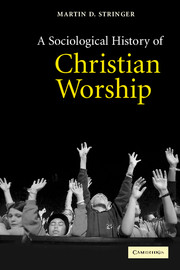Book contents
- Frontmatter
- Contents
- Preface and acknowledgements
- Introduction: Discourse, devotion and embodiment
- 1 Early Christian worship, texts and contexts to ad 300
- 2 Worship and the Christianisation of public space, 300–600
- 3 Hegemonic discourses in the worship of empires, 600–900
- 4 The dominant discourse of cosmological Christianity, 900–1200
- 5 Accessing the demotic discourses of devotion, 1200–1500
- 6 Worship and the rise of humanistic discourses, 1500–1800
- 7 The globalisation of Christian worship, 1800–2000
- Bibliography
- Index
Introduction: Discourse, devotion and embodiment
Published online by Cambridge University Press: 03 December 2009
- Frontmatter
- Contents
- Preface and acknowledgements
- Introduction: Discourse, devotion and embodiment
- 1 Early Christian worship, texts and contexts to ad 300
- 2 Worship and the Christianisation of public space, 300–600
- 3 Hegemonic discourses in the worship of empires, 600–900
- 4 The dominant discourse of cosmological Christianity, 900–1200
- 5 Accessing the demotic discourses of devotion, 1200–1500
- 6 Worship and the rise of humanistic discourses, 1500–1800
- 7 The globalisation of Christian worship, 1800–2000
- Bibliography
- Index
Summary
HISTORIES OF WORSHIP
For almost as long as we have records of specifically Christian worship there has been a sense of the history of that worship. In his letter to the Corinthians, written twenty to thirty years after the death and resurrection of Jesus, Paul talks about what ‘I received from the Lord’ and ‘passed on to you’. This sense of tradition is also central to many of the earliest commentators. The compilers of what were to become known as the ‘church orders’ in the third and fourth centuries made a feature both of the supposed apostolic origin of these orders and of their collecting together of elements of the tradition. ‘Tradition’ dominated Christian thinking on the history of worship for much of the first fifteen hundred years, with the explicit assumption that all Christians continued the practices instituted by Jesus and his Apostles. Beginning in the seventeenth century, however, new ideas began to develop and the understanding of a ‘history’ of Christian worship began to take root.
With printing and the development of scholarship Benedictine monks such as J. Mabillon (1632–1707) and E. Martène (1654–1739) began to collect together, and print, the various manuscripts relating to their own specific ‘tradition’. It was in studying these manuscripts, noting their differences and developments, and in tracing these through time that the origins of ‘liturgical’ study can be seen. The study of the ‘liturgy’, that is of the texts of Christian worship, continued to develop over the centuries.
- Type
- Chapter
- Information
- A Sociological History of Christian Worship , pp. 1 - 25Publisher: Cambridge University PressPrint publication year: 2005



